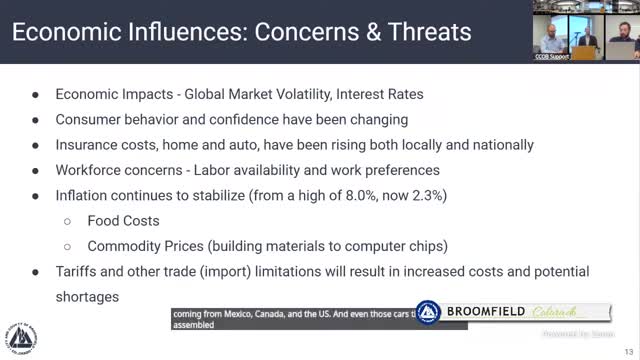Broomfield reports 6,000-unit housing pipeline; inclusionary rules producing units but housing fund may run low
February 08, 2025 | Broomfield County, Colorado
This article was created by AI summarizing key points discussed. AI makes mistakes, so for full details and context, please refer to the video of the full meeting. Please report any errors so we can fix them. Report an error »

BROOMFIELD, Colo. — City planning and housing staff on Saturday briefed the City and County Council on the near-term housing pipeline, inclusionary housing outcomes and a looming shortfall in the local Housing Development Fund.
Annifer (Anna) Casetti, deputy city and county manager for development, told council that roughly 6,000 residential units are at various stages of planning review or approval in Broomfield. “We have 6,000 residential units in the pipeline for development,” Casetti said, and she added most are already zoning- or site-plan approved, with developers waiting for market or financing conditions before building.
Nut graf: Staff said the pipeline will expand the community’s housing stock but warned it will increase service demands. Casetti and planning staff said the city’s inclusionary housing ordinance has successfully produced hundreds of attainable units within market-rate projects — staff estimate about 1,200 inclusionary units among the 6,000 pipeline total — but that success has reduced cash-in-lieu revenues into the Housing Development Fund, which the city uses for gap financing and housing programs.
Casetti and planning staff walked council through major projects in the queue, including phases at Flatirons Crossing and a series of large multifamily proposals clustered in 2026–2028. Staff estimated that of the approximately 6,000 units, about 1,200 are likely to be delivered as inclusionary or otherwise “attainable” units because developers are choosing to build the required affordable units rather than pay cash-in-lieu.
That outcome, staff said, is positive for housing availability but has a fiscal trade-off: cash paid into the Housing Development Fund previously funded gap financing and programs run by the local housing authority and nonprofits. Planning staff reported the housing fund is at risk of near-term depletion if cash-in-lieu revenues do not return; staff asked council to anticipate requests for continued program support and for gap financing on projects that rely on local subsidies.
Staff also described the Ulysses project, which was approved with a package of local and state support. Staff said the city is passing a state grant through to a project partner; in the meeting staff explained the state awarded $2 million to the city and the city is providing an additional $2 million, for a combined $4 million subsidy structure. Staff clarified that the state grant is a pass-through to the project and that city obligations are contingent on grant conditions and project performance.
Ending: Staff asked council to consider the approaching exhaustion of the Housing Development Fund when reviewing the 2026 budget and said housing gap-financing requests could require new funding sources if developers continue to build inclusionary units in place of paying cash-in-lieu.
Annifer (Anna) Casetti, deputy city and county manager for development, told council that roughly 6,000 residential units are at various stages of planning review or approval in Broomfield. “We have 6,000 residential units in the pipeline for development,” Casetti said, and she added most are already zoning- or site-plan approved, with developers waiting for market or financing conditions before building.
Nut graf: Staff said the pipeline will expand the community’s housing stock but warned it will increase service demands. Casetti and planning staff said the city’s inclusionary housing ordinance has successfully produced hundreds of attainable units within market-rate projects — staff estimate about 1,200 inclusionary units among the 6,000 pipeline total — but that success has reduced cash-in-lieu revenues into the Housing Development Fund, which the city uses for gap financing and housing programs.
Casetti and planning staff walked council through major projects in the queue, including phases at Flatirons Crossing and a series of large multifamily proposals clustered in 2026–2028. Staff estimated that of the approximately 6,000 units, about 1,200 are likely to be delivered as inclusionary or otherwise “attainable” units because developers are choosing to build the required affordable units rather than pay cash-in-lieu.
That outcome, staff said, is positive for housing availability but has a fiscal trade-off: cash paid into the Housing Development Fund previously funded gap financing and programs run by the local housing authority and nonprofits. Planning staff reported the housing fund is at risk of near-term depletion if cash-in-lieu revenues do not return; staff asked council to anticipate requests for continued program support and for gap financing on projects that rely on local subsidies.
Staff also described the Ulysses project, which was approved with a package of local and state support. Staff said the city is passing a state grant through to a project partner; in the meeting staff explained the state awarded $2 million to the city and the city is providing an additional $2 million, for a combined $4 million subsidy structure. Staff clarified that the state grant is a pass-through to the project and that city obligations are contingent on grant conditions and project performance.
Ending: Staff asked council to consider the approaching exhaustion of the Housing Development Fund when reviewing the 2026 budget and said housing gap-financing requests could require new funding sources if developers continue to build inclusionary units in place of paying cash-in-lieu.
View full meeting
This article is based on a recent meeting—watch the full video and explore the complete transcript for deeper insights into the discussion.
View full meeting
